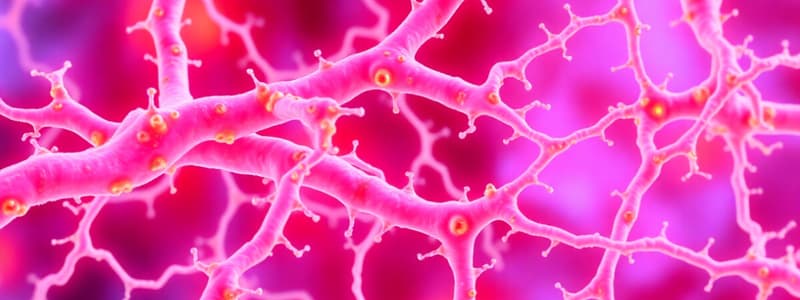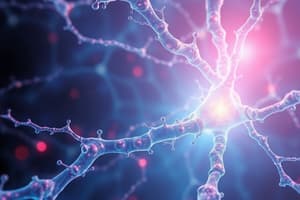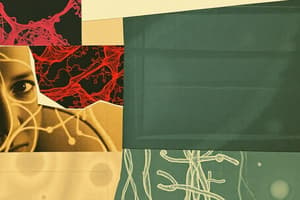Podcast
Questions and Answers
What is the primary role of fibroblasts in connective tissue?
What is the primary role of fibroblasts in connective tissue?
- Synthesize most of the connective extracellular matrix (ECM) (correct)
- Phagocytize invading organisms
- Participate in the immune response
- Surround endothelial cells
Which type of fibroblast is specialized in wound healing and has contractile properties?
Which type of fibroblast is specialized in wound healing and has contractile properties?
- Myofibroblasts (correct)
- Mast cells
- Reticular cells
- Fibrocytes
Which cell type is known to contain granules that release heparin and histamine during an immune response?
Which cell type is known to contain granules that release heparin and histamine during an immune response?
- Pericytes
- Macrophages
- Neutrophils
- Mast cells (correct)
What is a distinguishing feature of macrophages in connective tissue?
What is a distinguishing feature of macrophages in connective tissue?
Pericytes can differentiate into which of the following cell types upon certain stimuli?
Pericytes can differentiate into which of the following cell types upon certain stimuli?
Which of the following cells is not classified as a type of leukocyte?
Which of the following cells is not classified as a type of leukocyte?
What characterizes neutrophils in terms of their structure?
What characterizes neutrophils in terms of their structure?
What is a primary characteristic of eosinophils as granulocytes?
What is a primary characteristic of eosinophils as granulocytes?
What role do structural glycoproteins play in the extracellular matrix (ECM)?
What role do structural glycoproteins play in the extracellular matrix (ECM)?
Which of the following statements about collagen fibers is true?
Which of the following statements about collagen fibers is true?
What is the cellular origin of the most abundant type of collagen, Type I?
What is the cellular origin of the most abundant type of collagen, Type I?
Which vitamin is essential for the proper formation of collagen fibers?
Which vitamin is essential for the proper formation of collagen fibers?
What happens if there is a deficiency of vitamin C regarding collagen functionality?
What happens if there is a deficiency of vitamin C regarding collagen functionality?
Which type of collagen is primarily found in cartilage?
Which type of collagen is primarily found in cartilage?
Reticular fibers are primarily composed of which type of collagen?
Reticular fibers are primarily composed of which type of collagen?
How are tropocollagen molecules assembled in the collagen synthesis process?
How are tropocollagen molecules assembled in the collagen synthesis process?
Which type of cell is primarily involved in fighting viral infections?
Which type of cell is primarily involved in fighting viral infections?
Which connective tissue is characterized by a gelatinous matrix rich in hyaluronic acid?
Which connective tissue is characterized by a gelatinous matrix rich in hyaluronic acid?
What is a defining characteristic of dense connective tissue?
What is a defining characteristic of dense connective tissue?
Which type of granulocyte is stained with basic dyes and regulates allergic reactions?
Which type of granulocyte is stained with basic dyes and regulates allergic reactions?
Where is elastic connective tissue commonly found?
Where is elastic connective tissue commonly found?
What type of connective tissue fills the interstitial space of organs and is located below epithelia?
What type of connective tissue fills the interstitial space of organs and is located below epithelia?
Which connective tissue appears in the dermis and nerve sheaths and is characterized by disordered fiber arrangement?
Which connective tissue appears in the dermis and nerve sheaths and is characterized by disordered fiber arrangement?
What is the main function of plasma cells?
What is the main function of plasma cells?
What type of cells are primarily responsible for developing specific functions in connective tissue?
What type of cells are primarily responsible for developing specific functions in connective tissue?
Which stem cell type is responsible for the formation of both leukocytes and erythrocytes?
Which stem cell type is responsible for the formation of both leukocytes and erythrocytes?
Which characteristic is true about undifferentiated mesenchymal stem cells?
Which characteristic is true about undifferentiated mesenchymal stem cells?
What function do fibroblasts primarily serve in connective tissue?
What function do fibroblasts primarily serve in connective tissue?
Which cell type is NOT derived from an undifferentiated mesenchymal stem cell?
Which cell type is NOT derived from an undifferentiated mesenchymal stem cell?
What type of stem cell provides a similar function to mesenchymal stem cells in adults?
What type of stem cell provides a similar function to mesenchymal stem cells in adults?
Which of the following statements about transient cells in connective tissue is correct?
Which of the following statements about transient cells in connective tissue is correct?
What type of connective tissue cell is characterized by having an ovoid nucleus and being elongated?
What type of connective tissue cell is characterized by having an ovoid nucleus and being elongated?
What primarily constitutes elastic fibers?
What primarily constitutes elastic fibers?
Which cell type is responsible for the synthesis of the basement membrane?
Which cell type is responsible for the synthesis of the basement membrane?
What is one primary function of connective tissue?
What is one primary function of connective tissue?
What is the role of fibroblasts in the synthesis of elastic fibers?
What is the role of fibroblasts in the synthesis of elastic fibers?
Which component contributes to the viscosity and resistance to compression in the extracellular matrix?
Which component contributes to the viscosity and resistance to compression in the extracellular matrix?
How are reticular fibers primarily formed in the reticular lamina?
How are reticular fibers primarily formed in the reticular lamina?
What distinguishes permanent cells in connective tissue from transient cells?
What distinguishes permanent cells in connective tissue from transient cells?
What are proteoglycans formed from?
What are proteoglycans formed from?
Which is true about hyaluronic acid?
Which is true about hyaluronic acid?
Which two layers form the basement membrane?
Which two layers form the basement membrane?
What is NOT a characteristic of extracellular matrix (ECM) in connective tissue?
What is NOT a characteristic of extracellular matrix (ECM) in connective tissue?
What is the main function of type IV collagen in the basement membrane?
What is the main function of type IV collagen in the basement membrane?
Which of the following is NOT considered a resident cell in connective tissue?
Which of the following is NOT considered a resident cell in connective tissue?
Which of the following types of fibers are found in connective tissue?
Which of the following types of fibers are found in connective tissue?
What role does the ground substance play in the extracellular matrix?
What role does the ground substance play in the extracellular matrix?
Which of the following cells is NOT typically found in connective tissue?
Which of the following cells is NOT typically found in connective tissue?
Flashcards
Structural Glycoproteins
Structural Glycoproteins
Proteins bound to branched polysaccharides, acting as anchors for epithelia to the extracellular matrix (ECM) and linking ECM components like collagen fibers and proteoglycans.
Extracellular Matrix (ECM)
Extracellular Matrix (ECM)
A complex, non-living network of macromolecules that surrounds cells, providing structural support, organization, and communication.
ECM Fibers
ECM Fibers
Fibers that provide tensile strength and elasticity to tissues, enabling them to resist pulling forces and return to their original shape.
Collagen
Collagen
Signup and view all the flashcards
Procollagen
Procollagen
Signup and view all the flashcards
Tropocollagen
Tropocollagen
Signup and view all the flashcards
Vitamin C
Vitamin C
Signup and view all the flashcards
Type II Collagen
Type II Collagen
Signup and view all the flashcards
Connective tissue
Connective tissue
Signup and view all the flashcards
Ground substance
Ground substance
Signup and view all the flashcards
Glycosaminoglycans (GAGs)
Glycosaminoglycans (GAGs)
Signup and view all the flashcards
Proteoglycans
Proteoglycans
Signup and view all the flashcards
Collagen fibers
Collagen fibers
Signup and view all the flashcards
Elastic fibers
Elastic fibers
Signup and view all the flashcards
Reticular fibers
Reticular fibers
Signup and view all the flashcards
Elastin biosynthesis
Elastin biosynthesis
Signup and view all the flashcards
Basement membrane
Basement membrane
Signup and view all the flashcards
Basal lamina
Basal lamina
Signup and view all the flashcards
Reticular lamina
Reticular lamina
Signup and view all the flashcards
Permanent cells of connective tissue
Permanent cells of connective tissue
Signup and view all the flashcards
Transient cells of connective tissue
Transient cells of connective tissue
Signup and view all the flashcards
Fibroblasts
Fibroblasts
Signup and view all the flashcards
Mesenchymal stem cells
Mesenchymal stem cells
Signup and view all the flashcards
Chondroblasts
Chondroblasts
Signup and view all the flashcards
Osteoblasts
Osteoblasts
Signup and view all the flashcards
Adipocytes
Adipocytes
Signup and view all the flashcards
Hematopoietic stem cell
Hematopoietic stem cell
Signup and view all the flashcards
Osteocytes
Osteocytes
Signup and view all the flashcards
Basophils
Basophils
Signup and view all the flashcards
Monocytes
Monocytes
Signup and view all the flashcards
Lymphocytes
Lymphocytes
Signup and view all the flashcards
Mesenchymal Connective Tissue
Mesenchymal Connective Tissue
Signup and view all the flashcards
Mucoid Connective Tissue
Mucoid Connective Tissue
Signup and view all the flashcards
Loose Connective Tissue
Loose Connective Tissue
Signup and view all the flashcards
Dense Connective Tissue
Dense Connective Tissue
Signup and view all the flashcards
Elastic Connective Tissue
Elastic Connective Tissue
Signup and view all the flashcards
Reticular Cells
Reticular Cells
Signup and view all the flashcards
Myofibroblasts
Myofibroblasts
Signup and view all the flashcards
Pericytes
Pericytes
Signup and view all the flashcards
Mast Cells
Mast Cells
Signup and view all the flashcards
Macrophages
Macrophages
Signup and view all the flashcards
Leukocytes
Leukocytes
Signup and view all the flashcards
Neutrophils
Neutrophils
Signup and view all the flashcards
Study Notes
Connective Tissue Overview
- Connective tissue provides structural and metabolic support to other tissues
- It's a vascularized tissue, meaning it has blood and lymphatic vessels for nutrient delivery and waste removal.
- Plays a role in defense, protection, and repair of the body.
- Composed of cells and extracellular matrix (ECM).
Extracellular Matrix (ECM)
- A complex of macromolecules secreted by cells into the space between them.
- Present in large amounts in connective tissue with a limited number of cells scattered within it.
- Composed of two main components: ground substance and fibers.
ECM: Ground Substance
- Amorphous, gelatinous material
- Primarily composed of water and three other components:
- Glycosaminoglycans (GAGs)
- Proteoglycans
- Structural glycoproteins
Glycosaminoglycans (GAGs)
- Long chains of repeating disaccharides
- Mostly sulfated, except for hyaluronic acid, which is the largest GAG and unsulfated.
- Negatively charged, attracting positive ions like Na+ and drawing in large amounts of water, making the ECM resistant to compression.
Proteoglycans
- Formed when GAGs bind to a protein core.
- Vary in size and type.
- Hyaluronic acid can bind numerous proteoglycans to form an aggregate.
Structural Glycoproteins
- Proteins bound to branched polysaccharides.
- Have binding sites for various ECM components
- Anchor epithelia to the matrix & connect matrix elements (e.g., collagen & proteoglycans).
ECM: Fibers
- Provide tensile strength and elasticity.
- Two main types in connective tissue:
- Collagen
- Elastin
Collagen Fibers
- Non-elastic, hard, and firm proteins.
- Most abundant proteins in the body.
- Highly resistant to traction.
- At least 35 different types, distinguished by amino acid sequence.
Collagen Biosynthesis
- Fibroblasts synthesize procollagen, a precursor molecule.
- Procollagen is released into the ECM, where it becomes activated tropocollagen.
- Tropocollagen molecules spontaneously assemble in a head-tail arrangement to form collagen microfibrils, then fibrils, then fibers.
- Vitamin C is crucial for proper collagen formation. Deficiency can lead to weakened tissues and bleeding disorders (scurvy).
Collagen Types
- Type I: Most abundant, supports skin, tendons, ligaments, and bones.
- Type II: Found in cartilage.
- Type III: Forms reticular fibers, supporting delicate organs and tissues.
- Type IV: Forms part of the basement membrane, supporting epithelial cells, muscles and Schwann cells.
- Others: at least 35 types, with various functions supporting tissue structure, such as binding other components or stabilizing the matrix.
Elastic Fibers
- Made of elastin protein and fibrillin.
- Thin, long, and branched.
- Provide elasticity to tissues.
Elastin Biosynthesis
- Fibroblasts and smooth muscle cells synthesize elastin.
- Tropoelastin molecules polymerize, binding to fibrillin microfibrils.
- Combining these creates elastic fibers.
Basement Membrane
- Non-cellular layer between epithelium and connective tissue.
- Similar structure surrounds skeletal, smooth muscle cells, adipocytes, and Schwann cells.
- Composed of basal lamina and reticular lamina.
Basal Lamina
- Synthesized by the epithelium.
- Comprised of structural glycoproteins and integrin fractions attaching to the epithelium; type IV collagen.
- Acts as a filter between epithelium and connective tissue.
Reticular Lamina
- Synthesized by the connective tissue.
- Consists primarily of reticular fibers (type III collagen) anchoring the basal lamina to the connective tissue.
Connective Tissue Cells: Permanent/Resident
- Fibroblasts (support and maintain the ECM).
- Adipocytes (store fat).
- Pericytes (support the endothelial cells lining blood vessels).
- Mast cells (release inflammatory mediators).
- Macrophages (phagocytosis, waste removal, defense).
Connective Tissue Cells: Transient/Wandering
- Leukocytes (part of the immune system).
- Plasma cells (secrete antibodies).
Origin of Connective Tissue Cells
- Many connective tissue cells derive from mesenchymal stem cells.
- Mesenchymal stem cells differentiate into various cells as needed.
- Cells also originate from the bone marrow and circulate in the blood stream to perform specific functions within connective tissues.
Mesenchymal Stem Cells
- Undifferentiated, pluripotent cells
- Irregular shape with cytoplasmic projections.
- Found primarily in embryonic connective tissue.
- Pericytes in adults have a similar function to Mesenchymal stem cells.
Fibroblasts
- Main cells of connective tissue, numerous and widely distributed.
- Elongated cells with ovoid nuclei.
- Generate the ECM.
- When inactive, are called fibrocytes.
- Specialized forms exist, such as myofibroblasts and reticular cells (specialized in generating reticular fibers).
Reticular Cells
- Fibroblasts specializing in reticular fiber generation.
- Extend many projections creating supportive networks in the cellular organs.
Myofibroblasts
- Fibroblasts with contractile properties.
- Resemble fibroblasts but have more contractile capabilities.
- Crucial in wound healing.
- Present in seminiferous tubules.
Pericytes
- Also derive from mesenchymal stem cells.
- Surround endothelial cells of capillaries.
- Can differentiate into other cell types (fibroblasts, endothelial cells, smooth muscle).
Mast Cells
- Largest permanent CT cells with oval shape and central nucleus.
- Contain granules (with heparin (anticoagulant), histamine (inflammation), and other molecules).
- Role in immune system, releasing contents when stimulated by antigens.
Macrophages
- Some are permanent, others are transient cells.
- Large, irregular cells derived from monocytes that circulate in the blood and then evolve into macrophages in tissues.
- Phagocytic (engulfing and destroying waste, pathogens, etc), and crucial in both removing waste and fighting infections.
Leukocytes
- Migratory cells of the connective tissue originating in bone marrow.
- Several types, each with different roles in inflammation and immunity (some granulocytes, monocytes, and lymphocytes).
- Critical in the body's immune activity.
Plasma Cells
- Derived from B lymphocytes (types of white blood cells).
- Rounded with an eccentric nucleus.
- Produce and secrete antibodies, helping the body defend against specific pathogens.
Classification of Connective Tissue
- Embryonic: mesenchymal CT (found in embryos), mucoid (umbilical cord, embryonic tissues)
- Adult: Loose, Dense, Elastic and Reticular tissues (each with different fiber arrangements, cell densities, and functions).
Loose Connective Tissue
- Abundant ground substance and tissue fluid.
- Few fibers, scattered randomly.
- Easily vascularized and innervated.
- Fills space between organs and other tissues under epithelium.
Dense Connective Tissue
- Abundant fibers, few cells.
- Collagen fibers bundled, offering high resistance to stress.
- Irregular dense connective tissue (disorganized bundles), found in the dermis, nerve sheaths, and muscles.
- Regular dense connective tissue (parallel bundles), found in tendons and ligaments.
Elastic Connective Tissue
- Thick bundles of elastic fibers arranged parallel and joined by surrounding loose connective tissue.
- Found in blood vessels and certain ligaments.
Reticular Connective Tissue
- Reticular cells and reticular fibers form a network to support tissues and organs with a high cellularity (like the spleen and lymph nodes).
Studying That Suits You
Use AI to generate personalized quizzes and flashcards to suit your learning preferences.




